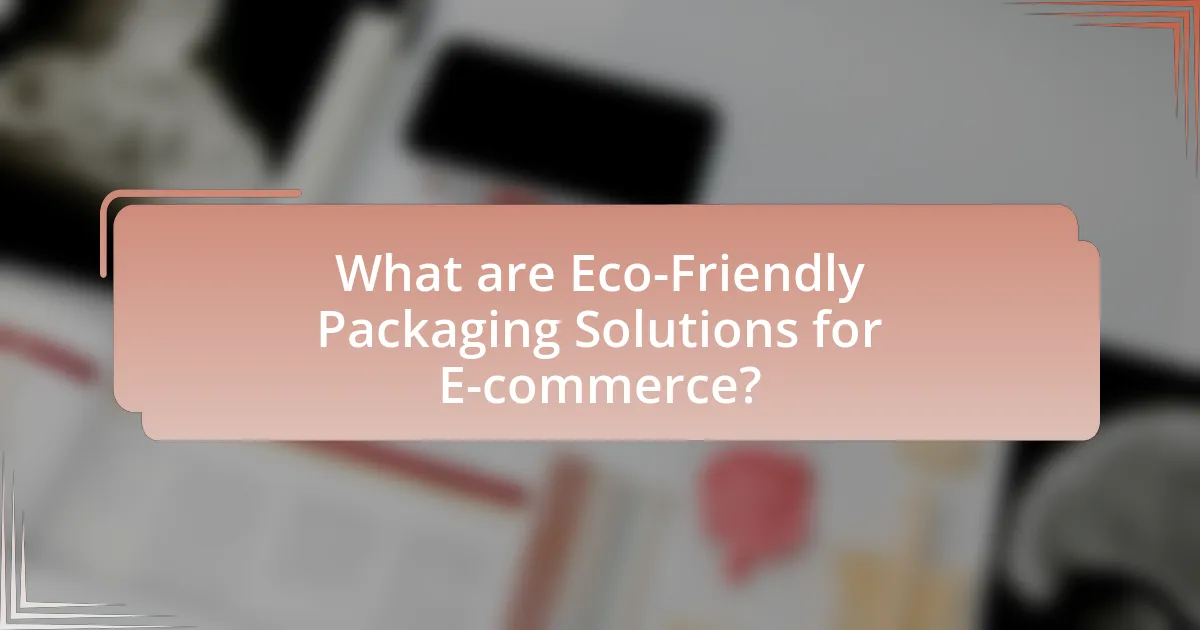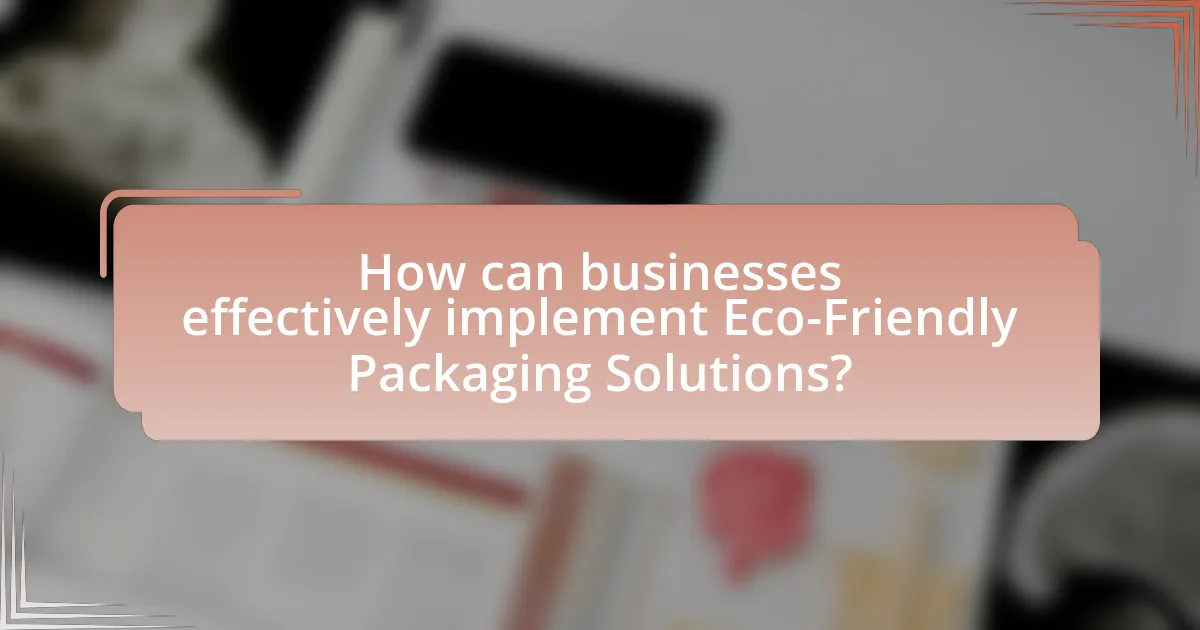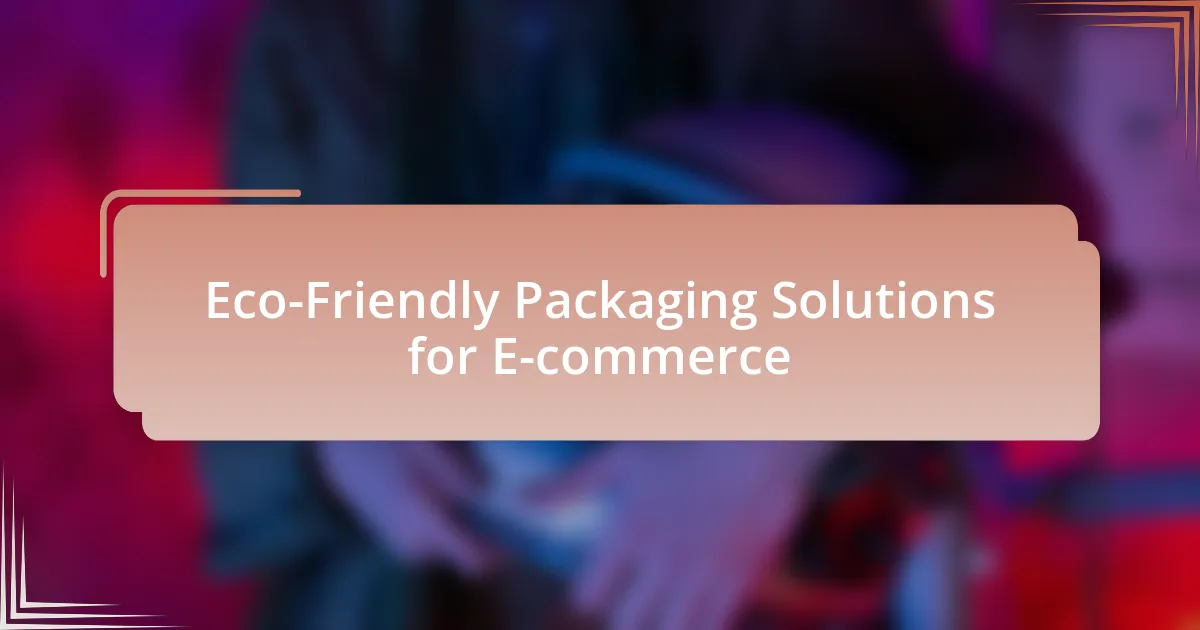Eco-friendly packaging solutions for e-commerce encompass biodegradable materials, recycled paper, and reusable packaging, all aimed at reducing environmental impact. These alternatives differ from traditional packaging by utilizing sustainable resources that minimize waste and pollution. The article explores the various types of eco-friendly packaging, including biodegradable and compostable options, and highlights their benefits, such as enhancing brand reputation and meeting consumer demand for sustainability. Additionally, it addresses the challenges businesses face in implementing these solutions, including cost considerations and logistical hurdles, while providing practical steps for effective transition and consumer education.

What are Eco-Friendly Packaging Solutions for E-commerce?
Eco-friendly packaging solutions for e-commerce include biodegradable materials, recycled paper, and reusable packaging. Biodegradable materials, such as plant-based plastics, decompose naturally, reducing landfill waste. Recycled paper products, like boxes and fillers, utilize post-consumer waste, minimizing the need for virgin materials. Reusable packaging, such as durable containers that can be returned and reused, promotes sustainability by reducing single-use items. According to a 2021 report by Smithers Pira, the global market for sustainable packaging is projected to reach $500 billion by 2027, indicating a significant shift towards eco-friendly practices in the e-commerce sector.
How do Eco-Friendly Packaging Solutions differ from traditional packaging?
Eco-friendly packaging solutions differ from traditional packaging primarily in their materials and environmental impact. Eco-friendly packaging is made from sustainable, biodegradable, or recyclable materials, such as plant-based plastics or recycled paper, which reduce waste and pollution. In contrast, traditional packaging often relies on non-biodegradable plastics and materials that contribute to landfill overflow and environmental degradation. For instance, a study by the Ellen MacArthur Foundation indicates that only 14% of plastic packaging is recycled globally, highlighting the inefficiency of traditional methods. This stark difference emphasizes the growing need for eco-friendly alternatives in e-commerce to minimize ecological footprints.
What materials are commonly used in Eco-Friendly Packaging?
Common materials used in eco-friendly packaging include recycled paper, biodegradable plastics, and plant-based materials. Recycled paper is widely utilized due to its ability to reduce waste and conserve resources, while biodegradable plastics, made from renewable sources like cornstarch, decompose more easily than traditional plastics. Additionally, plant-based materials, such as bamboo and sugarcane, are increasingly favored for their sustainability and minimal environmental impact. These materials collectively contribute to reducing the carbon footprint associated with packaging in e-commerce.
How do these materials impact the environment?
Eco-friendly packaging materials significantly reduce environmental impact by minimizing waste and pollution. These materials, such as biodegradable plastics and recycled paper, decompose more easily than traditional packaging, leading to less landfill accumulation. For instance, biodegradable plastics can break down within months under the right conditions, compared to conventional plastics that can take hundreds of years. Additionally, using recycled materials decreases the demand for virgin resources, which conserves energy and reduces greenhouse gas emissions associated with production. Studies indicate that switching to eco-friendly packaging can lower carbon footprints by up to 30%, demonstrating their effectiveness in promoting sustainability.
Why is Eco-Friendly Packaging important for E-commerce businesses?
Eco-friendly packaging is important for e-commerce businesses because it enhances brand reputation and meets consumer demand for sustainable practices. Research indicates that 72% of consumers are willing to pay more for products with eco-friendly packaging, demonstrating a clear market preference. Additionally, using sustainable materials can reduce waste and lower carbon footprints, aligning with global sustainability goals. This not only attracts environmentally conscious customers but also helps businesses comply with increasing regulations on packaging waste, ultimately leading to improved customer loyalty and competitive advantage.
What role does consumer demand play in the adoption of Eco-Friendly Packaging?
Consumer demand significantly drives the adoption of eco-friendly packaging by influencing companies to prioritize sustainable practices. As consumers increasingly prefer environmentally responsible products, businesses respond by integrating eco-friendly packaging solutions to meet this demand. For instance, a 2021 survey by McKinsey found that 60% of consumers are willing to change their shopping habits to reduce environmental impact, prompting brands to adopt sustainable packaging to attract and retain customers. This shift not only aligns with consumer preferences but also enhances brand loyalty and market competitiveness.
How can Eco-Friendly Packaging enhance brand reputation?
Eco-friendly packaging enhances brand reputation by demonstrating a commitment to sustainability and environmental responsibility. Brands that utilize eco-friendly packaging can attract environmentally conscious consumers, as studies show that 66% of global consumers are willing to pay more for sustainable brands. This positive perception can lead to increased customer loyalty and trust, ultimately enhancing the brand’s image in a competitive market. Furthermore, eco-friendly packaging can differentiate a brand from competitors, as consumers increasingly prefer products that align with their values, reinforcing the brand’s reputation as a leader in sustainability.
What are the challenges of implementing Eco-Friendly Packaging Solutions?
The challenges of implementing eco-friendly packaging solutions include higher costs, limited material availability, and consumer acceptance. Higher costs arise because sustainable materials often have a premium price compared to traditional packaging options, which can deter businesses from adopting them. Limited material availability can hinder production, as not all regions have access to eco-friendly materials, impacting supply chains. Additionally, consumer acceptance poses a challenge; many consumers may not prioritize sustainability, leading to reluctance in purchasing products with eco-friendly packaging. These factors collectively complicate the transition to sustainable packaging in the e-commerce sector.
What cost considerations should businesses keep in mind?
Businesses should consider material costs, production costs, and shipping costs when implementing eco-friendly packaging solutions for e-commerce. Material costs involve the price of sustainable materials such as recycled paper or biodegradable plastics, which can be higher than traditional packaging options. Production costs may increase due to the need for specialized manufacturing processes that accommodate eco-friendly materials. Shipping costs can also be affected, as lighter and more compact packaging can reduce overall shipping expenses, while heavier or bulkier eco-friendly options may increase these costs. According to a study by the Sustainable Packaging Coalition, companies that invest in sustainable packaging can see a return on investment through enhanced brand loyalty and reduced waste disposal costs, reinforcing the importance of these considerations.
How can businesses overcome logistical challenges associated with Eco-Friendly Packaging?
Businesses can overcome logistical challenges associated with eco-friendly packaging by optimizing supply chain processes and collaborating with sustainable suppliers. Efficient supply chain management ensures that eco-friendly materials are sourced and delivered in a timely manner, reducing delays and costs. For instance, companies can implement just-in-time inventory systems to minimize excess stock and waste. Collaborating with suppliers who specialize in sustainable materials can also streamline the procurement process, as these suppliers often have established logistics networks that prioritize eco-friendly practices. According to a report by McKinsey & Company, companies that integrate sustainability into their supply chains can improve operational efficiency by up to 30%, demonstrating that strategic partnerships and optimized logistics can effectively address the challenges of eco-friendly packaging.

What are the different types of Eco-Friendly Packaging Solutions available?
The different types of eco-friendly packaging solutions available include biodegradable packaging, compostable packaging, recycled packaging, and reusable packaging. Biodegradable packaging breaks down naturally over time, reducing landfill waste. Compostable packaging not only decomposes but also enriches the soil, making it suitable for organic waste. Recycled packaging utilizes materials that have been processed from previous products, minimizing the need for new raw materials. Reusable packaging is designed for multiple uses, significantly decreasing waste generation. According to a report by Smithers Pira, the global market for sustainable packaging is projected to reach $500 billion by 2027, highlighting the growing demand for these eco-friendly solutions.
What are biodegradable packaging options?
Biodegradable packaging options include materials such as plant-based plastics, paper, and cardboard, which decompose naturally over time. Plant-based plastics, made from renewable resources like corn starch or sugarcane, can break down in industrial composting facilities within a few months. Paper and cardboard are derived from trees and can biodegrade in a matter of weeks to months, depending on environmental conditions. Additionally, mushroom-based packaging, created from agricultural waste and mycelium, is another innovative option that is fully compostable. These materials contribute to reducing landfill waste and minimizing environmental impact, aligning with sustainable practices in e-commerce.
How do biodegradable materials break down in the environment?
Biodegradable materials break down in the environment through natural processes involving microorganisms, moisture, and temperature. These materials are designed to decompose into natural substances like water, carbon dioxide, and biomass within a specific timeframe when exposed to these environmental conditions. For instance, studies show that materials such as polylactic acid (PLA) can degrade in industrial composting facilities within 90 to 180 days, while other biodegradable plastics may take longer depending on the conditions. This breakdown process is facilitated by bacteria, fungi, and other decomposers that metabolize the organic compounds, ultimately returning nutrients to the soil and reducing waste in landfills.
What are the benefits of using biodegradable packaging for E-commerce?
Biodegradable packaging for E-commerce offers significant environmental benefits by reducing plastic waste and promoting sustainability. This type of packaging decomposes naturally, minimizing landfill contributions and pollution. According to a study published in the journal “Waste Management,” biodegradable materials can break down within months, unlike traditional plastics that can take hundreds of years. Additionally, using biodegradable packaging can enhance brand image, as consumers increasingly prefer eco-friendly products; a survey by Nielsen found that 66% of global consumers are willing to pay more for sustainable brands. Thus, adopting biodegradable packaging not only supports environmental health but also aligns with consumer preferences, driving sales and loyalty.
What is compostable packaging and how does it work?
Compostable packaging is a type of packaging made from organic materials that can decompose into natural substances in a composting environment. This process typically occurs within a specific timeframe, usually 90 to 180 days, under the right conditions of heat, moisture, and microbial activity. The materials used in compostable packaging, such as plant-based plastics, paper, and other biodegradable substances, break down into carbon dioxide, water, and biomass, enriching the soil without leaving harmful residues. According to the Biodegradable Products Institute, compostable packaging must meet specific standards, such as ASTM D6400 or EN 13432, to ensure it can effectively decompose in commercial composting facilities.
What materials are used in compostable packaging?
Compostable packaging is primarily made from materials such as plant-based bioplastics, paper, cardboard, and natural fibers like cornstarch, sugarcane, and bamboo. These materials are designed to break down into non-toxic components in composting environments, contributing to soil health. For instance, polylactic acid (PLA), derived from corn starch, is a common bioplastic used in compostable packaging, which has been shown to decompose within 90 to 180 days under industrial composting conditions.
How does compostable packaging contribute to sustainability?
Compostable packaging contributes to sustainability by reducing waste and promoting a circular economy. Unlike traditional plastic packaging, which can take hundreds of years to decompose, compostable materials break down into organic matter within a few months when exposed to the right conditions. This process not only minimizes landfill contributions but also enriches soil health, supporting plant growth. According to a study by the Biodegradable Products Institute, compostable packaging can divert significant amounts of waste from landfills, thereby lowering greenhouse gas emissions associated with waste decomposition.
What role does recycled packaging play in Eco-Friendly Solutions?
Recycled packaging plays a crucial role in eco-friendly solutions by significantly reducing waste and conserving natural resources. By utilizing materials that have already been processed, companies can decrease the demand for virgin materials, which in turn lowers energy consumption and greenhouse gas emissions associated with production. For instance, the recycling of paper and cardboard can save up to 24% of the energy required to produce new paper from trees, according to the Environmental Protection Agency. This not only minimizes landfill contributions but also promotes a circular economy where materials are reused, thus enhancing sustainability in e-commerce practices.
How is recycled packaging produced?
Recycled packaging is produced through a multi-step process that begins with the collection of used materials, such as paper, cardboard, and plastics. These materials are sorted, cleaned, and processed to remove contaminants, ensuring that only suitable materials are used for production. For instance, in the case of paper recycling, the collected paper is pulped, which breaks it down into fibers that can be reformed into new paper products. According to the Environmental Protection Agency, recycling paper can save 60% of the energy required to produce new paper from virgin materials. This process not only reduces waste but also conserves natural resources, making recycled packaging a sustainable choice for e-commerce businesses.
What are the environmental benefits of using recycled materials?
Using recycled materials significantly reduces environmental impact by conserving natural resources, decreasing energy consumption, and minimizing waste. For instance, recycling one ton of paper can save 17 trees, 7,000 gallons of water, and 4,100 kilowatts of electricity, which is enough to power an average home for six months. Additionally, utilizing recycled materials in manufacturing processes typically requires less energy compared to producing new materials, leading to lower greenhouse gas emissions. According to the Environmental Protection Agency, recycling and composting prevented the release of approximately 186 million metric tons of carbon dioxide equivalent into the air in 2013, highlighting the substantial benefits of recycling for climate change mitigation.

How can businesses effectively implement Eco-Friendly Packaging Solutions?
Businesses can effectively implement eco-friendly packaging solutions by adopting sustainable materials, optimizing packaging design, and engaging in recycling initiatives. Utilizing biodegradable, compostable, or recyclable materials reduces environmental impact, as evidenced by a study from the Ellen MacArthur Foundation, which highlights that shifting to sustainable packaging can significantly decrease plastic waste. Additionally, optimizing packaging design to minimize excess material not only lowers costs but also enhances shipping efficiency, as demonstrated by companies like Unilever, which reported a 20% reduction in packaging weight through design improvements. Finally, engaging customers in recycling initiatives fosters a culture of sustainability, as seen in Coca-Cola’s “World Without Waste” campaign, which aims to collect and recycle a bottle or can for every one sold by 2030.
What steps should businesses take to transition to Eco-Friendly Packaging?
Businesses should conduct a comprehensive assessment of their current packaging materials and processes to transition to eco-friendly packaging. This involves identifying non-sustainable materials, such as plastics, and researching alternative options like biodegradable, compostable, or recyclable materials.
Next, businesses should engage suppliers who specialize in sustainable packaging solutions, ensuring that the materials meet environmental standards and certifications. Implementing a pilot program to test the new packaging can provide insights into performance and customer feedback.
Additionally, businesses should educate their staff and customers about the benefits of eco-friendly packaging, fostering a culture of sustainability. Tracking and measuring the impact of the transition on waste reduction and customer satisfaction will help refine the approach and demonstrate the effectiveness of the new packaging strategy.
According to a 2021 study by McKinsey & Company, 60% of consumers are willing to pay more for sustainable packaging, highlighting the market demand for eco-friendly solutions.
How can businesses assess their current packaging practices?
Businesses can assess their current packaging practices by conducting a comprehensive audit of their packaging materials, processes, and environmental impact. This involves evaluating the types of materials used, their recyclability, and the overall sustainability of the packaging design. For instance, a study by the Ellen MacArthur Foundation highlights that 95% of plastic packaging is discarded after a single use, indicating a need for businesses to shift towards more sustainable options. Additionally, businesses can gather feedback from customers regarding packaging effectiveness and sustainability, which can provide insights into areas for improvement.
What resources are available to help businesses find Eco-Friendly suppliers?
Businesses can find eco-friendly suppliers through various resources such as online directories, certification organizations, and industry-specific platforms. Online directories like Green Pages and EcoBusinessLinks provide comprehensive listings of suppliers committed to sustainable practices. Certification organizations, including the Forest Stewardship Council and the Global Organic Textile Standard, offer verified supplier lists that meet specific environmental standards. Additionally, platforms like ThomasNet and Alibaba have sections dedicated to eco-friendly products, allowing businesses to filter suppliers based on sustainability criteria. These resources facilitate informed sourcing decisions by connecting businesses with suppliers that prioritize environmental responsibility.
What best practices should businesses follow when using Eco-Friendly Packaging?
Businesses should prioritize the use of biodegradable materials, such as plant-based plastics or recycled paper, when implementing eco-friendly packaging. This approach reduces landfill waste and minimizes environmental impact, as biodegradable materials decompose more quickly than traditional plastics. Additionally, companies should optimize packaging size to reduce material usage and shipping emissions, which can lead to a 30% reduction in carbon footprint according to the Environmental Protection Agency. Furthermore, businesses should educate consumers about the benefits of eco-friendly packaging, enhancing brand loyalty and encouraging sustainable practices among customers.
How can businesses educate consumers about their Eco-Friendly initiatives?
Businesses can educate consumers about their Eco-Friendly initiatives through targeted communication strategies. These strategies include utilizing social media platforms to share informative content, creating engaging blog posts that detail the environmental benefits of their initiatives, and implementing in-store signage that highlights sustainable practices. For instance, a study by Nielsen found that 66% of global consumers are willing to pay more for sustainable brands, indicating a strong market interest in eco-friendly practices. Additionally, businesses can host workshops or webinars to discuss their initiatives and encourage consumer participation, further enhancing awareness and understanding of their eco-friendly efforts.
What metrics should businesses track to measure the effectiveness of Eco-Friendly Packaging?
Businesses should track metrics such as customer satisfaction, return rates, cost savings, and environmental impact to measure the effectiveness of eco-friendly packaging. Customer satisfaction can be assessed through surveys that gauge consumer perceptions of packaging sustainability. Return rates can indicate whether eco-friendly packaging meets product protection standards; lower return rates suggest effective packaging. Cost savings can be calculated by comparing expenses related to traditional packaging versus eco-friendly alternatives, with studies showing that sustainable packaging can reduce costs by up to 20%. Environmental impact can be measured through metrics like carbon footprint reduction and waste diversion rates, with research indicating that eco-friendly packaging can reduce greenhouse gas emissions by 30% compared to conventional materials.
What are common misconceptions about Eco-Friendly Packaging?
Common misconceptions about eco-friendly packaging include the belief that it is always more expensive, less durable, and less effective than traditional packaging. In reality, while some eco-friendly options may have a higher upfront cost, many alternatives can be cost-competitive when considering long-term benefits and reduced waste disposal costs. Additionally, advancements in materials have led to eco-friendly packaging that is both durable and effective, often matching or exceeding the performance of conventional materials. For instance, studies show that biodegradable plastics can perform comparably to traditional plastics in various applications, debunking the myth of inferior quality.
How can businesses address myths surrounding the cost of Eco-Friendly Packaging?
Businesses can address myths surrounding the cost of Eco-Friendly Packaging by providing transparent pricing comparisons and showcasing long-term savings. For instance, studies indicate that while initial costs may be higher, eco-friendly packaging can reduce waste disposal costs and enhance brand loyalty, leading to increased sales. Additionally, businesses can highlight that many eco-friendly materials are becoming more affordable due to advancements in technology and increased demand, which can further dispel the myth that sustainable options are prohibitively expensive.
What are the truths about the performance of Eco-Friendly Packaging compared to traditional options?
Eco-friendly packaging often performs comparably to traditional options in terms of protection and durability, but it typically has a lower environmental impact. Studies indicate that materials like biodegradable plastics and recycled paper can provide similar levels of protection for products while reducing waste. For instance, a 2020 study published in the Journal of Cleaner Production found that biodegradable packaging can reduce greenhouse gas emissions by up to 70% compared to conventional plastic packaging. Additionally, eco-friendly packaging solutions are increasingly designed to meet the same performance standards as traditional materials, ensuring that they can effectively safeguard products during shipping and handling.
What practical tips can businesses follow to enhance their Eco-Friendly Packaging efforts?
Businesses can enhance their Eco-Friendly Packaging efforts by adopting sustainable materials, optimizing package design, and implementing recycling programs. Utilizing biodegradable or recyclable materials, such as plant-based plastics or recycled paper, reduces environmental impact. Optimizing package design to minimize waste, such as using smaller boxes or eliminating excess filler, can significantly lower material usage. Additionally, establishing recycling programs encourages customers to return packaging for reuse, promoting a circular economy. According to a 2021 study by the Ellen MacArthur Foundation, transitioning to sustainable packaging can reduce greenhouse gas emissions by up to 70%.


